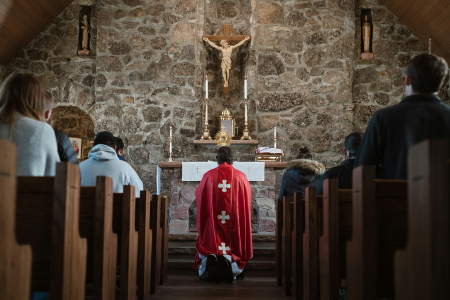 Hi readers, it seems you use Catholic Online a lot; that's great! It's a little awkward to ask, but we need your help. If you have already donated, we sincerely thank you. We're not salespeople, but we depend on donations averaging $14.76 and fewer than 1% of readers give. If you donate just $5.00, the price of your coffee, Catholic Online School could keep thriving. Thank you. Help Now >
Hi readers, it seems you use Catholic Online a lot; that's great! It's a little awkward to ask, but we need your help. If you have already donated, we sincerely thank you. We're not salespeople, but we depend on donations averaging $14.76 and fewer than 1% of readers give. If you donate just $5.00, the price of your coffee, Catholic Online School could keep thriving. Thank you. Help Now >
John Gower
FREE Catholic Classes
Poet; born between 1327-1330, probably in Kent; died October, 1408. He was of gentle blood and well connected. He may have been a merchant in London, but this cannot be authoritatively affirmed. It seems certain from his writings that, even if trained to the profession of the law, he did not practise it. Leland's statements that he frequented the law courts and studied the laws of his country for gain, and that he was chief judge of the Common Pleas, are no longer accepted as correct. The latter statement was, as a matter of fact, subsequently withdrawn by Leland, but the revival of it by Fuller gave it a wide vogue and a long-continued persistence. The poet was undoubtedly wealthy, being an owner of landed property in the Counties of Norfolk, Suffolk, and Kent, and possibly also in Essex. That he was a man of some standing at court, as well as a writer of acknowledged eminence, may be inferred from his statement in the first version of his "Confessio Amantis", (ll. 43-53), that on one occasion King Richard II recognized him in a boat on the Thames, invited him into the royal barge, and charged him to write some new thing for the monarch's own inspection and delectation. John Gower, the poet, has been by some writers identified with one John Gower, clerk, who by grant from King Richard II held the rectory of Great Braxted in Essex from 1390 to 1397. That the poet and the clerk were one and the same person may, however, reasonably be doubted. According to Gower himself he was not a clerk when he wrote the "Mirour de l'Omme" (l. 21772: Pour ce que je ne suy pas clers ), and in the Prologus (l. 52) of the "Confessio Amantis" he calls himself a "burel clerk", that is, a man of simple learning or a layman. At all events we may safely conclude that he was not in full Holy orders, for in January, 1397-8, when he was about seventy years of age, he married Agnes Groundolf, and it might be inferred from some passages in his works that she was not his first wife. At that time he was living in the priory of St. Mary Overy (now St. Saviour), Southwark, to which he was a generous benefactor, and he continued to reside there after his marriage. About 1400 he became blind. He died in October, 1408, and was buried in the chapel of St. John the Baptist in St. Mary Overy. His tomb is still to be seen. His effigy lies under a canopy, with the head resting on a pillow formed of three folio volumes inscribed with the titles of his three best-known works, namely, the "Speculum Meditantis", the "Vox Clamantis", and the "Confessio Amantis."
Gower wrote in three languages, French, Latin, and English. His French works are the "Mirour de l'Omme", or "Speculum Hominis", which modern research has almost to a certainty identified with the "Speculum Meditantis", long supposed to be lost; the "Cinkante Balades"; and the "Traitié". The "Mirour de l'Omme", as we now have it, consists of 28,603 lines, but, as some leaves at the beginning, throughout the work, and at the end are missing from the manuscript, it probably consisted in its complete state of about 31,000 lines. It is written in twelve-line stanzas of octosyllabic verse, with two sets of rhymes in each stanza arranged aab aab bba bba. It is divided into ten parts, treats of vices and virtues and of the different grades of society, and endeavors to print out the path by which a sinner may return to God and obtain pardon through the aid of Our Lord Jesus Christ and of His sweet mother, the glorious Virgin. It concludes with a life of Our Lady , into which is also naturally introduced an account of the principal events in the life of Christ. It was probably written about 1376-1379.
The "Cinkante (i.e. Cinquante, Fifty) Balades" really contains fifty-two, or, if we count the two of the dedication, fifty-four. The first fifty-one deal in various ways with the passion of love ; the last of the series is in honour of the Blessed Virgin, with a general envoi. The dedication to Henry IV comprises, besides the French verse, some Latin verse and two Latin prose quotations. Each balade contains normally either twenty-eight or twenty-five lines of ten-syllable verse, divided into three stanzas of eight or seven lines respectively, with an envoi of four lines; but there are occasional deviations from this model. There are different rhyming schemes in the work. It is likely that the "Balades" were written at various periods in the poet's life and that they were brought together, in the order and form in which we now have them, in 1399.
The "Traitié" deals with the married state and seeks to show by precept and example the obligation of observing the marriage vow. It is written in ten-syllable verse, and consists of eighteen balades, each balade containing three seven-line stanzas. The rhymes are arranged thus: ab ab bcc. It concludes with one stanza in the nature of an envoi -- "Al université de tout le monde" -- appended to the eighteenth balade, and this envoi-stanza is in turn followed by thirty-six rhymed Latin hexameters and pentameters. There are also Latin marginal explanations of the different points discussed. The "Traitié" was probably written in 1397.
The "Cinkante Balades" and the "Traitié" were printed by the Roxburghe Club in 1818 (ed. Earl Gower), and by Dr. Edmund Stengel in 1886. All the French works were printed by G.C. Macaulay in 1899, the "Mirour de l'Omme" for the first time.
The Latin works of Gower are the "Vox Clamantis", the "Cronica Tripertita", some eighteen shorter poems, the verses, and marginal and other summaries already mentioned or to be mentioned below, and probably a preface, found in several manuscripts, describing his three principal poems. The "Vox Clamantis" contains 10,265 lines of elegiac verse. It is in seven books, of which the first three have prologues, also in elegiacs. Prefixed to the whole there is a prose summary of each book. It deals with the rising of the peasants in 1381; the need of pure religious faith ; the vices of the clergy of every degree, of the merchants, of the lawyers, and of the common people; and the duties of a king. It calls on Richard II to select wise consellors, to avoid heavy and oppressive taxation, to abandon sensuality, to restore the laws and to banish crime. In the last book the poet shows the evils of vice and the necessity of repentance. It was probably begun in 1381 or 1382 and completed about 1399.
The "Cronica Tripertita" is written in rhyming hexameters and is in three parts, containing 1055 lines, with Latin prose marginal summaries. It gives an account of King Richard's management of the affairs of the realm from 1387 until his deposition and the accession of Henry IV in 1399. It was probably written soon after the latter date. The "Vox Clamantis" and the "Cronica Tripertita", together with some of the minor Latin poems, were printed by the Roxburghe Club in 1850 (ed. H.O. Coxe); the "Cronica Tripertita" and some minor poems were printed in the "Political Poems", Rolls Series, by T. Wright; and four other minor poems were printed by Karl Meyer in his dissertation entitled "John Gower's Beziehungen Zu Chaucer und Richard II" (1889). All the Latin poems were printed by G.C. Macaulay in 1902.
Gower's English works are the "Confessio Amantis" and a poem addressed to King Henry IV , which from its subject has been called "In Praise of Peace". The "Confessio Amantis" is in a prologue and eight books. It is written throughout in octosyllabic rhyming couplets, with Latin verses interspersed and a Latin marginal summary of the text. It contains altogether 33,446 English lines. It was begun probably between 1383 and 1386, and finished in 1390, and it underwent two subsequent revisions about 1391 and 1393. In its plan, which was doubtless borrowed from the "Roman de la Rose", this work is a dialogue first between the poet, in the character of a lover, and Venus, and afterwards between the poet, in the character of a penitent, and Genius, whom Venus assigns to him as a confessor. In the conversation between the penitent and the confessor the seven deadly sins are discussed and illustrated by tales borrowed from Ovid, Josephus, Vincent de Beauvais, Statius, the "Gesta Romanorum", the Bible , and other sources. In the eighth book, having described the duty of a king and prayed for England, the poet bids farewell to earthly love.
The "Confessio Amantis" has come down to us in three classes of manuscripts. The principal deviations of the later from the earlier forms are the omissions (1) of the mention of Richard II in the prologue as the inspirer of the work, and (2) of complimentary references to Chaucer near the end of the eighth book. The reasons for these omissions are somewhat obscure. In the case of the king the change in the text may perhaps be set down to a disapproval of the royal policy which grew up in Gower's mind between the time he began and that at which he completed the work, and this view is made all the more probable when we remember the severe way in which he elsewhere treats the youthful monarch. In the case of Chaucer the omission may have been due to a feeling on the part of Gower that the lines were irrelevant; but it is more likely to have been the result of a literary quarrel.
"In Praise of Peace" is a poem in fifty-six stanzas of seven lines each, rhyming ab ab bcc. It is dedicated to Henry IV and was probably written in 1400. It is followed by fifty-six lines of elegiac Latin verse.
The "Confession Amantis" was translated into Portuguese by Robert Payn, canon of the city of Lisbon, and into Spanish prose by Juan de Cuenca in 1400. It was printed by Caxton in 1483, by Berthelette in 1532 and 1554, by Chalmers in 1810, by Pauli in 1857, by Morley in 1899, and, with "In Praise of Peace", by G.C. Macaulay in 1901.
There are several manuscripts of Gower's works extant, ranging from forty-one (some of them imperfect) of the "Confessio Amantis" to one of the "Mirour de l'Omme", of the "Cinkante Balades", and of "In Praise of Peace". These manuscripts are to be found in various public and private libraries in London, Oxford, Cambridge, Glasgow, Lincoln, Dublin, Manchester, and elsewhere.
It is to be noted that while Gower on several occasions freely censures the vices of the clergy of every rank, secular and regular, he expressly disassociates himself from all sympathy with the Lollards, and strongly denounces "lollardie" in his later writings. He lived and died in full communion with the Catholic Church. It was unfortunate for Gower's reputation that for more than two centuries he was constantly associated with Chaucer and mentioned along with him, both being taken as typical writers of English verse of the fourteenth century. As the canons of criticism developed, it was inevitable that the minor poet should suffer from contrast with his great contemporary. Hence Gower has been generally relegated to an undeservedly inferior rank among poets. But in the "Cinkante Balades" at least he displays many true poetic qualities, and his art of telling a story in a natural way, as shown for example in the "Confession Amantis", is by no means slender, and in some respects will stand comparison with Chaucer's admittedly great gifts as a narrator.
 Hi readers, it seems you use Catholic Online a lot; that's great! It's a little awkward to ask, but we need your help. If you have already donated, we sincerely thank you. We're not salespeople, but we depend on donations averaging $14.76 and fewer than 1% of readers give. If you donate just $5.00, the price of your coffee, Catholic Online School could keep thriving. Thank you. Help Now >
Hi readers, it seems you use Catholic Online a lot; that's great! It's a little awkward to ask, but we need your help. If you have already donated, we sincerely thank you. We're not salespeople, but we depend on donations averaging $14.76 and fewer than 1% of readers give. If you donate just $5.00, the price of your coffee, Catholic Online School could keep thriving. Thank you. Help Now >
We ask you, humbly: don't scroll away.
Hi readers, it seems you use Catholic Online a lot; that's great! It's a little awkward to ask, but we need your help. If you have already donated, we sincerely thank you. We're not salespeople, but we depend on donations averaging $14.76 and fewer than 1% of readers give. If you donate just $5.00, the price of your coffee, Catholic Online School could keep thriving. Thank you.Help Now >
Join the Movement
When you sign up below, you don't just join an email list - you're joining an entire movement for Free world class Catholic education.
-

-
Mysteries of the Rosary
-
St. Faustina Kowalska
-
Litany of the Blessed Virgin Mary
-
Saint of the Day for Wednesday, Oct 4th, 2023
-
Popular Saints
-
St. Francis of Assisi
-
Bible
-
Female / Women Saints
-
7 Morning Prayers you need to get your day started with God
-
Litany of the Blessed Virgin Mary
U.S. Catholic Parishes Experience Resurgence of Traditional Practices
-

Pope Francis Urges Faith and Prayers for Peace
-

Florida Welcomes Volunteer Chaplains to Public Schools
-
10 Fascinating Details About St. Joseph the Worker: Celebrating His Feast Day - May 1
-
St. Joseph the Worker: Model for Men, Young and Old
Daily Catholic
 Daily Readings for Thursday, May 02, 2024
Daily Readings for Thursday, May 02, 2024 St. Athanasius: Saint of the Day for Thursday, May 02, 2024
St. Athanasius: Saint of the Day for Thursday, May 02, 2024 The Our Father: Prayer of the Day for Thursday, May 02, 2024
The Our Father: Prayer of the Day for Thursday, May 02, 2024- Daily Readings for Wednesday, May 01, 2024
- St. Marculf: Saint of the Day for Wednesday, May 01, 2024
- To Saint Peregrine: Prayer of the Day for Wednesday, May 01, 2024
We ask you, humbly: don't scroll away.
Hi readers, it seems you use Catholic Online a lot; that's great! It's a little awkward to ask, but we need your help. If you have already donated, we sincerely thank you. We're not salespeople, but we depend on donations averaging $14.76 and fewer than 1% of readers give. If you donate just $5.00, the price of your coffee, Catholic Online School could keep thriving. Thank you.Help Now >
![]()
Copyright 2024 Catholic Online. All materials contained on this site, whether written, audible or visual are the exclusive property of Catholic Online and are protected under U.S. and International copyright laws, © Copyright 2024 Catholic Online. Any unauthorized use, without prior written consent of Catholic Online is strictly forbidden and prohibited.
Catholic Online is a Project of Your Catholic Voice Foundation, a Not-for-Profit Corporation. Your Catholic Voice Foundation has been granted a recognition of tax exemption under Section 501(c)(3) of the Internal Revenue Code. Federal Tax Identification Number: 81-0596847. Your gift is tax-deductible as allowed by law.










 Daily Readings for Thursday, May 02, 2024
Daily Readings for Thursday, May 02, 2024 St. Athanasius: Saint of the Day for Thursday, May 02, 2024
St. Athanasius: Saint of the Day for Thursday, May 02, 2024 The Our Father: Prayer of the Day for Thursday, May 02, 2024
The Our Father: Prayer of the Day for Thursday, May 02, 2024
